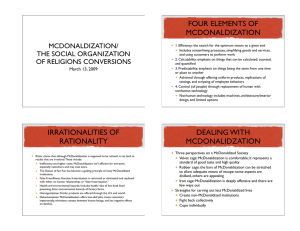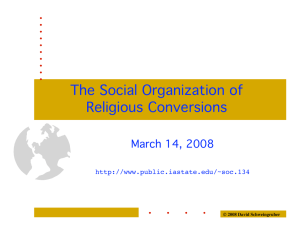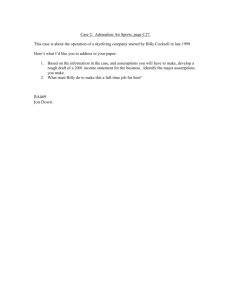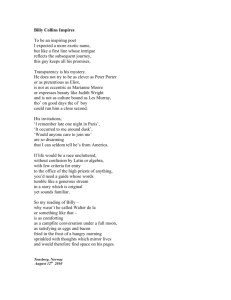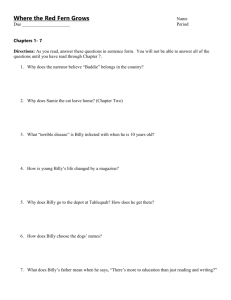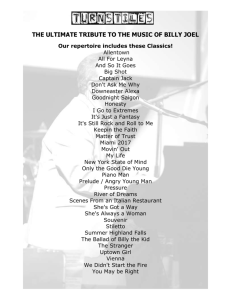IRRATIONALITIES OF RATIONALITY MCDONALDIZATION/THE SOCIAL ORGANIZATION OF
advertisement
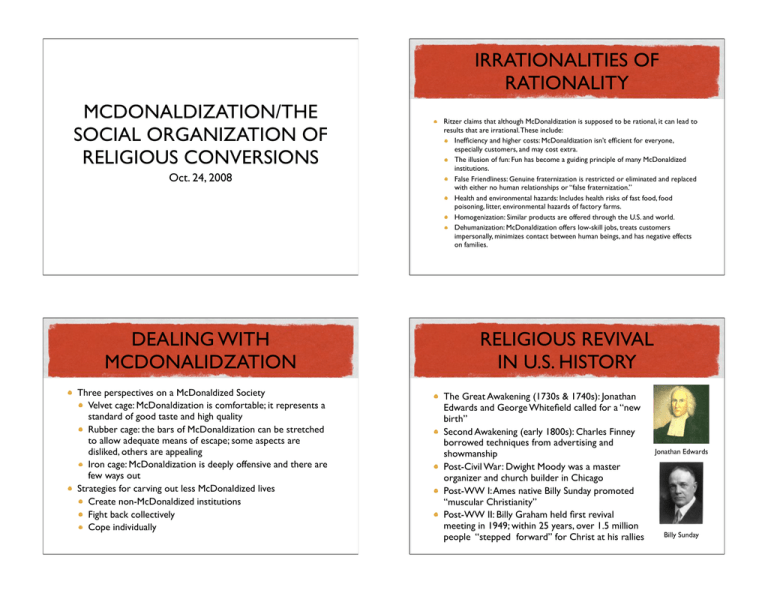
IRRATIONALITIES OF RATIONALITY MCDONALDIZATION/THE SOCIAL ORGANIZATION OF RELIGIOUS CONVERSIONS Oct. 24, 2008 DEALING WITH MCDONALIDZATION Three perspectives on a McDonaldized Society Velvet cage: McDonaldization is comfortable; it represents a standard of good taste and high quality Rubber cage: the bars of McDonaldization can be stretched to allow adequate means of escape; some aspects are disliked, others are appealing Iron cage: McDonaldization is deeply offensive and there are few ways out Strategies for carving out less McDonaldized lives Create non-McDonaldized institutions Fight back collectively Cope individually Ritzer claims that although McDonaldization is supposed to be rational, it can lead to results that are irrational. These include: Inefficiency and higher costs: McDonaldization isn’t efficient for everyone, especially customers, and may cost extra. The illusion of fun: Fun has become a guiding principle of many McDonaldized institutions. False Friendliness: Genuine fraternization is restricted or eliminated and replaced with either no human relationships or “false fraternization.” Health and environmental hazards: Includes health risks of fast food, food poisoning, litter, environmental hazards of factory farms. Homogenization: Similar products are offered through the U.S. and world. Dehumanization: McDonaldization offers low-skill jobs, treats customers impersonally, minimizes contact between human beings, and has negative effects on families. RELIGIOUS REVIVAL IN U.S. HISTORY The Great Awakening (1730s & 1740s): Jonathan Edwards and George Whitefield called for a “new birth” Second Awakening (early 1800s): Charles Finney borrowed techniques from advertising and showmanship Post-Civil War: Dwight Moody was a master organizer and church builder in Chicago Post-WW I: Ames native Billy Sunday promoted “muscular Christianity” Post-WW II: Billy Graham held first revival meeting in 1949; within 25 years, over 1.5 million people “stepped forward” for Christ at his rallies Jonathan Edwards Billy Sunday TWO VIEWS OF CONVERSION Turnabout view of conversion Radical break with past and immersion in a new life Institutionalized view of conversion Organized by families, churches and revivalists Often an age-stage ritual to affirm existing values Like other rituals, can still be meaningful experience Today’s sources: two studies & one documentary on Billy Graham Wimberly et al’s survey of Knoxville, TN, rally Altheide & Johnson’s covert participant observation of Phoenix, AZ, rally Video: Billy Graham (Biography series, Randall Balmer narrated) Billy Graham THE ROLE OF THE REVIVALISTS Publicity begins 18 months before event Organize churches to supply attendees Train counselors and other workers Provide message promoting conversion Provide “altar call” period for conversion Counselors go forward during altar call Counselors help converts through conversion Counselors record conversions Local churches notified to “follow up” conversion THE ROLE OF FAMILY AND CHURCHES Conversions organized by families and churches as lifestage ritual to re-affirm existing values (Wimberly et al. 1975) Method: survey at Knoxville Billy Graham rally 91% of attendees were church members Bloc mobilization: 31% came with church group Not break with family: 66% came with families/friends Life-stage ritual: 73% of conversions < 20 years old Research on conversions to a different religion, shows that conversions result from ties to people in that religious community BUREAUCRATIZING CONVERSIONS Altheide & Johnson: covert observation of 1974 Phoenix rally Research question: how are decisions made as to type of conversion in face-to-face encounters? Acceptance of Christ as Savior and Lord Assurance of Salvation Rededication Results: all converts categorized as “acceptance” Interpretation: organization environment engulfed spiritual priorities
